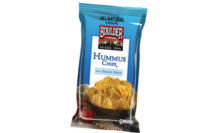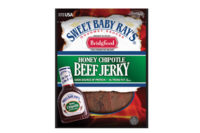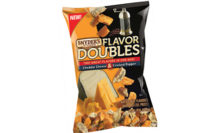Our 2013 State of the Industry report on snacks focuses on new snack products, the perspective of snack manufacturers and product leaders and market sales.
Sunbathers looking to shed a few pounds before lounging poolside are seeking out better-for-you snacks. With loads of protein and low carbs, the pork rind segment is benefitting from consumers’ focus on their weight and on healthier eating.
The regional nature of pork rinds is looking like a thing of the past. Previously a staple in the southern states, this high-protein snack is becoming more sought after across the country due to its healthful profile as compared to its carb-loaded counterparts. In fact, a report from ABC News states that, beginning in 1997, sales of pork rinds have risen from around $300 million to $400 million, increasing 15% or more every year.
“We continue to see solid pork rind growth in mass and convenience stores, but sales are flat in grocery,” says Mark Singleton, vice president of Rudolph Foods, Lima, Ohio, which sells its products through a variety of retail outlets and its website. “With mass sales growing, there could be a shift in dollars spent in other channels. For example, there has been more than 6% sales growth in the convenience channel.”
Compared to other snacks, pork rinds have lower household penetration, which means there is potential for growth and greater exposure to these products. “The word is getting out that pork rinds are a low-carb, high-protein snack,” Singleton says. “[There also are increasing sales opportunities], with the Hispanic and African American demographics [who are primary buyers of this snack] on the rise.”
The key to expanding the marketplace for pork rinds is educating consumers about them, including the different varieties available. “Many people aren’t familiar with pork skins, since they’re mainly a southern product,” says Reta Washington Johnson, managing partner at Julia’s Southern Foods, LLC, in Raleigh, N.C., which offers a variety of Southern foods, including microwavable pork rinds.
Pork rinds 101
Many consumers are unaware, for instance, that pork rinds are created from the cooked skin of a pig and that the production process absorbs the fat attached to the skin. The “rind” can be heated up and eaten as part of a meal, but is more commonly served cold as a snack in the form of chunks or pellets. In this form, the pork rind is deep fried into a light puff or curl and then seasoned.
Rudolph Foods slowly dries and cures its pork skins using hardwood smoke. “The production process and recipes have been unchanged for many years,” Singleton says. “The key step is the drying and smoke-curing process.”
Microwavable pork rinds are popped like popcorn and eaten warm. Julia’s Southern Foods recently introduced a 100-calorie snack pack in a Mylar bag that enables consumers to microwave the contents for on-the-go snacking. The product can also be heated on a plate in the microwave.
Richer, buttery-tasting, pickled pork rinds are refrigerated and served cold.
American pork rinds that are fried or roasted are often referred to as cracklings or cracklins. Due to its composition and the production technique, this type of pork rind is high in both fat and cholesterol. When produced as a snack, it is hand-rubbed with salt and scored with a sharp knife to produce a crisp and bubbly surface that contains cooked fat underneath. Cracklings are a component of both soul food and Cajun fare.
Cracklings have changed in the last 50 years. After the Food and Drug Administration (FDA) imposed new rules regarding the production and sales of cracklings in the early 1960s, these snacks became lighter and more heavily fried than the greasy counterparts sold at butcher shops and grocery stores.
Consumers’ continued focus on health and flavor trends are also impacting this segment. Those familiar with these products see pork rinds as a healthy snack and one that can be consumed while dieting. Consumers on high-protein/low-carb diets, in particular, have turned to pork rinds as a snacking solution.
Making headway
Because more consumers are discovering the protein benefits of pork rinds, the demographic for these products is expanding.
“Consumers are realizing that these products are a good diet supplement due to the high protein and low carbs,” says Laddie Fulcher, vice president of Turkey Creek Snacks, Thomaston, Ga.
Although there hasn’t been a big infiltration in the creation of low-sodium products in this segment, Turkey Creek’s pork rinds have less sodium on average, Fulcher says. “The flavorful products are the most popular, with barbecue outselling all the others,” he adds. “Also chili lime varieties are obtaining more interest in the expanding Hispanic market.”
One of the biggest challenges in selling pork rinds is getting the product lines onto store shelves. “When pork rinds are on the shelves, the public buys them,” Fulcher says. “Where we have coverage, we have great turnover and repeat sales.” Turkey Creek is currently working on new packaging to increase its products’ shelf life.
Displaying these snacks in the right area of a store is key, too. Julia’s Southern Foods is in talks with several large food stores that have approached the company about carrying its pork rind products. “The chains are deciding where to position these items, either by the chips in the snack aisle or by the meats,” says Richard Washington, Johnson’s father and partner.
Still, consumer unfamiliarity with pork rinds may be the biggest challenge to expanding the product’s consumer base. “Our product line has been enjoyed by many generations, but we are still educating people about pork rinds,” Singleton points out.
To provide greater exposure for pork rinds, Rudolph Foods partnered with former Chicago Bears football coach Mike Ditka and his The Gridiron Greats Assistance Fund (GGAF) to publicize Pork Appreciation Day last February. GGAF is a nonstock, nonprofit organization providing financial grants and pro bono medical assistance to retired National Football League players in need.
“This gives us the opportunity to talk about pork rinds and athletes,” Singleton says. “The Cave Man, Paleo and low-carb diets still have many advocates who are seeking snacks that are not full of carbs.” Rudolph Foods also provides a recipe exchange for pork rinds on its website and recently updated its pork rinds packaging.
“It can be difficult overcoming the fact that pork rinds have a bad rap as a snack due to fact that traditional pork rind is cooked in fat,” said Johnson. “This is still seen as a high-fat snack that doesn’t have other redeeming characteristics.”
Still, low-carb dieters and diabetics aren’t the only ones seeking out pork rinds nowadays. An increasing number of athletes, including runners, are, too. “Doctors are recommending these snacks, as far as sustaining protein,” Johnson says. “Pork rinds help with endurance better than high carbs, which provide a peak and then a drop.
“The other trend we’re seeing is with microwave pork rinds for those who don’t want fried skins. Our product also can be baked at 400 deg. for a few short minutes, which makes them puff up.”
Healthy eating has impacted Rudolph Foods’ sales in a big way, too. “We saw a large increase in sales when the low-carb diet became popular,” Singleton says. “With a high protein value, no carbs and less fat than a serving of potato chips, pork rinds have become a healthy snack option. And given that 43% of the fat is the same healthy, unsaturated fat as in olive oil, one serving goes a long way and leaves consumers less likely to snack unhealthily later on.”
Some like it hot
Given increasing consumer interest in pork rinds, it’s no wonder that snack manufacturers are diving deeper into the category with new product launches, especially in flavors trending toward the hot and spicy.
Florence, S.C.-based Wallace’s Old Fashion Skins Inc., for instance, says it has experienced an increase in requests for more varieties of its Cracklin Style pork rinds. “These pork rinds have more crunch and more flavor based on comments we’ve heard,” says M. Eugene Wallace, vice president of sales. “We offer our own Hot & Spicy, Tasty, Seasoned or Bar-B-Que style cracklins in a variety of sizes. The traditional Bar-B-Que flavored cracklins or pork rinds can be spicy hot or mildly hot. We also offer a Salt & Vinegar cracklin or pork rinds in various sizes.”
Rudolph Foods’ Chile Limon Chicharinas, which come with hot sauce packets, have been strong sellers for the company. “We now have the Bar-B-Que, Sweet Southern Bar-B-Q, Hot & Spicy and Salt & Vinegar options, which have become very popular,” says Singleton. He notes that the company is doing well with its new Sweet Barbecue line north of the Mason Dixon, but is seeing the more intense flavors do better in the South and Southwest.
“In Pepe’s bags, we are test marketing the inclusion of a packet of hot sauce, which has also become a huge hit,” Singleton continues. “The expansion into the flavor option gives consumers a way to branch out and gives pork rinds an entry into the snack world.”
Traditional puffy pork rinds are still the top seller at Henderson, N.C.-based Carolina Country Snacks. “Low-carb is making more of a comeback, and the focus on healthier eating has positively impacted the segment,” says Angela Jacobs, president of Carolina Country Snacks.
The company will be introducing new flavors this fall, including cinnamon sugar and a hot variety. “Consumers are seeking snacks with a lot of flavor,” Jacobs adds. “This is a strong segment that hasn’t contracted, but hasn’t grown a lot, either. It is ripe for growth.”
Increased consumer awareness of pork rinds’ healthy attributes and new on-trend flavors are certainly moving pork rinds from the wading pool to the competition pool when it comes to snack awareness and sales. Now, restaurants are helping put pork rinds on the map as well. “There has been much experimentation in restaurants with these products, which has been a boon to the segment,” Singleton adds. “The country is undergoing a ‘redneck renaissance,’ with people reaching out for comfort foods. Pork rinds are just pork and salt, so it doesn’t get more authentic than that.”








